Systematic Review: Oral Care with Antiseptics for VAP Prevention
VerifiedAdded on 2023/03/23
|39
|9911
|84
Report
AI Summary
This report presents a systematic review focused on the effectiveness of oral care, particularly with antiseptics like chlorhexidine, in preventing ventilator-associated pneumonia (VAP) in patients undergoing mechanical ventilation. The review encompasses studies evaluating oral hygiene interventions and their impact on VAP incidence, length of hospital stay, and duration of mechanical ventilation. The analysis includes critically ill patients of various ages and sexes, examining the use of oral care with antiseptics compared to control groups. Methodological quality is assessed using tools like the AMSTAR checklist, and data is synthesized narratively to evaluate the efficacy of oral mouth care using chlorhexidine. The findings suggest that consistent oral care with 2% chlorhexidine, performed multiple times daily, can significantly reduce the risk of VAP. The report concludes that oral mouth care combined with chlorhexidine is a highly effective strategy for both treating and preventing VAP, while also emphasizing the need for further research to refine these interventions.
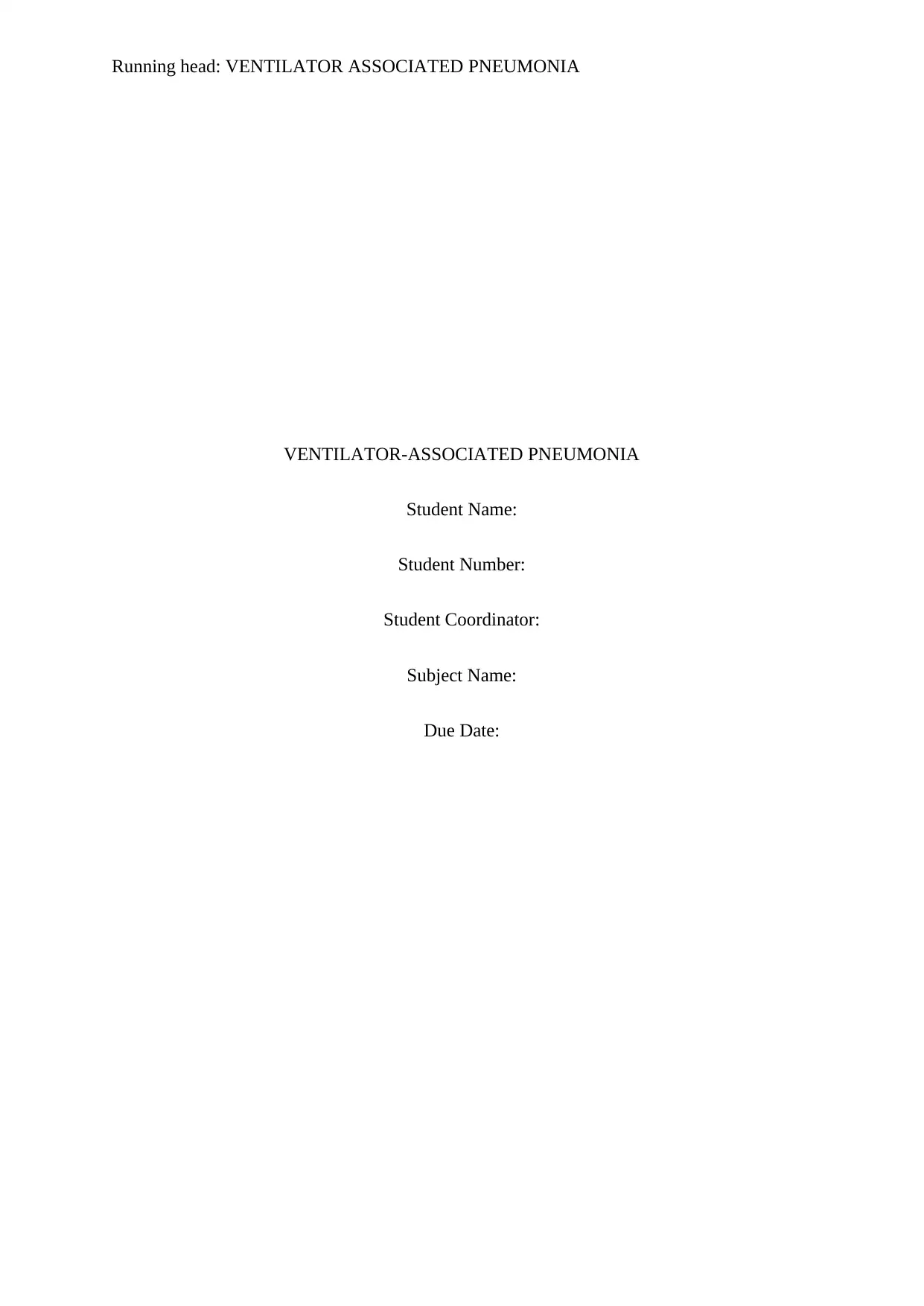
Running head: VENTILATOR ASSOCIATED PNEUMONIA
VENTILATOR-ASSOCIATED PNEUMONIA
Student Name:
Student Number:
Student Coordinator:
Subject Name:
Due Date:
VENTILATOR-ASSOCIATED PNEUMONIA
Student Name:
Student Number:
Student Coordinator:
Subject Name:
Due Date:
Paraphrase This Document
Need a fresh take? Get an instant paraphrase of this document with our AI Paraphraser
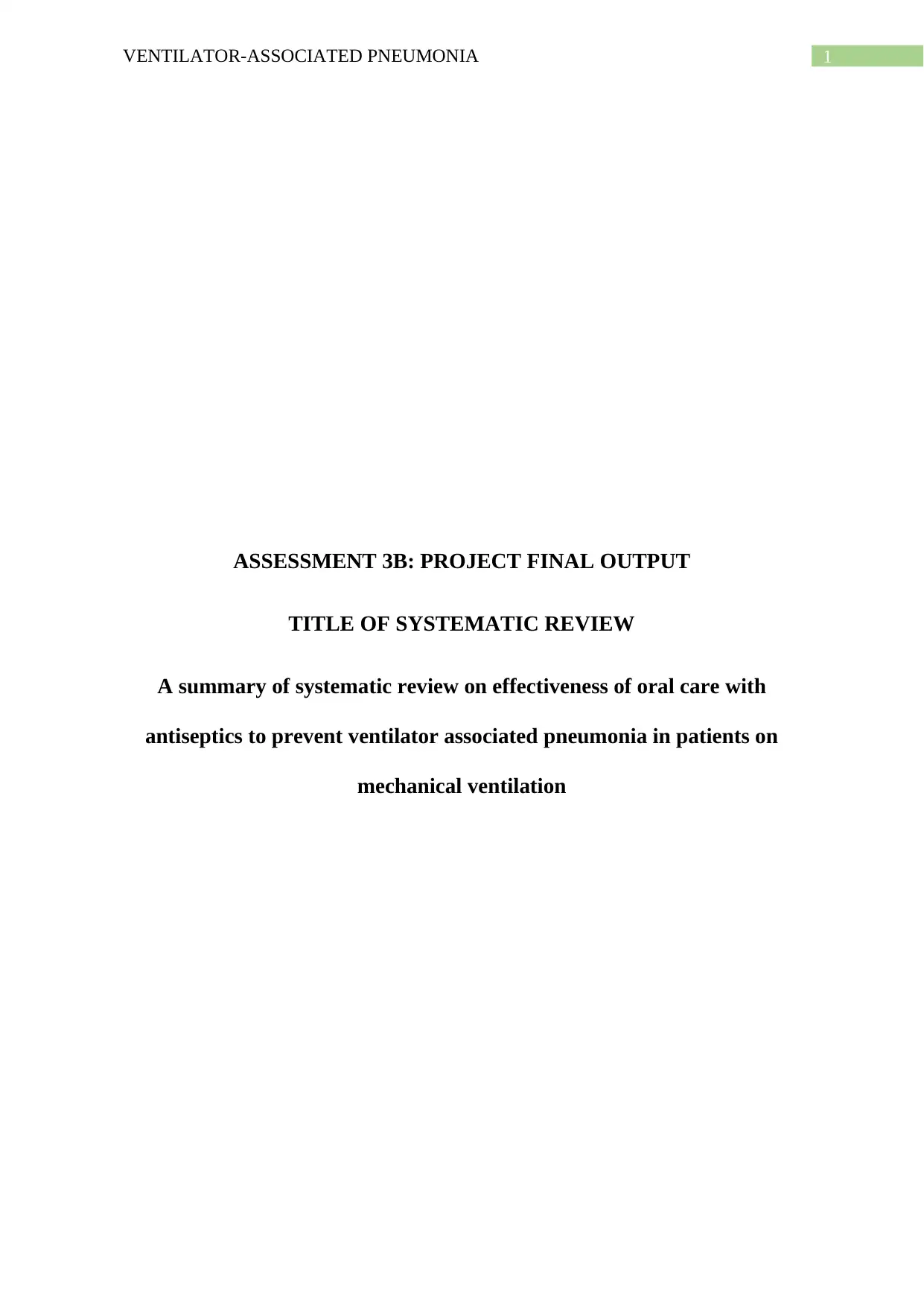
1VENTILATOR-ASSOCIATED PNEUMONIA
ASSESSMENT 3B: PROJECT FINAL OUTPUT
TITLE OF SYSTEMATIC REVIEW
A summary of systematic review on effectiveness of oral care with
antiseptics to prevent ventilator associated pneumonia in patients on
mechanical ventilation
ASSESSMENT 3B: PROJECT FINAL OUTPUT
TITLE OF SYSTEMATIC REVIEW
A summary of systematic review on effectiveness of oral care with
antiseptics to prevent ventilator associated pneumonia in patients on
mechanical ventilation
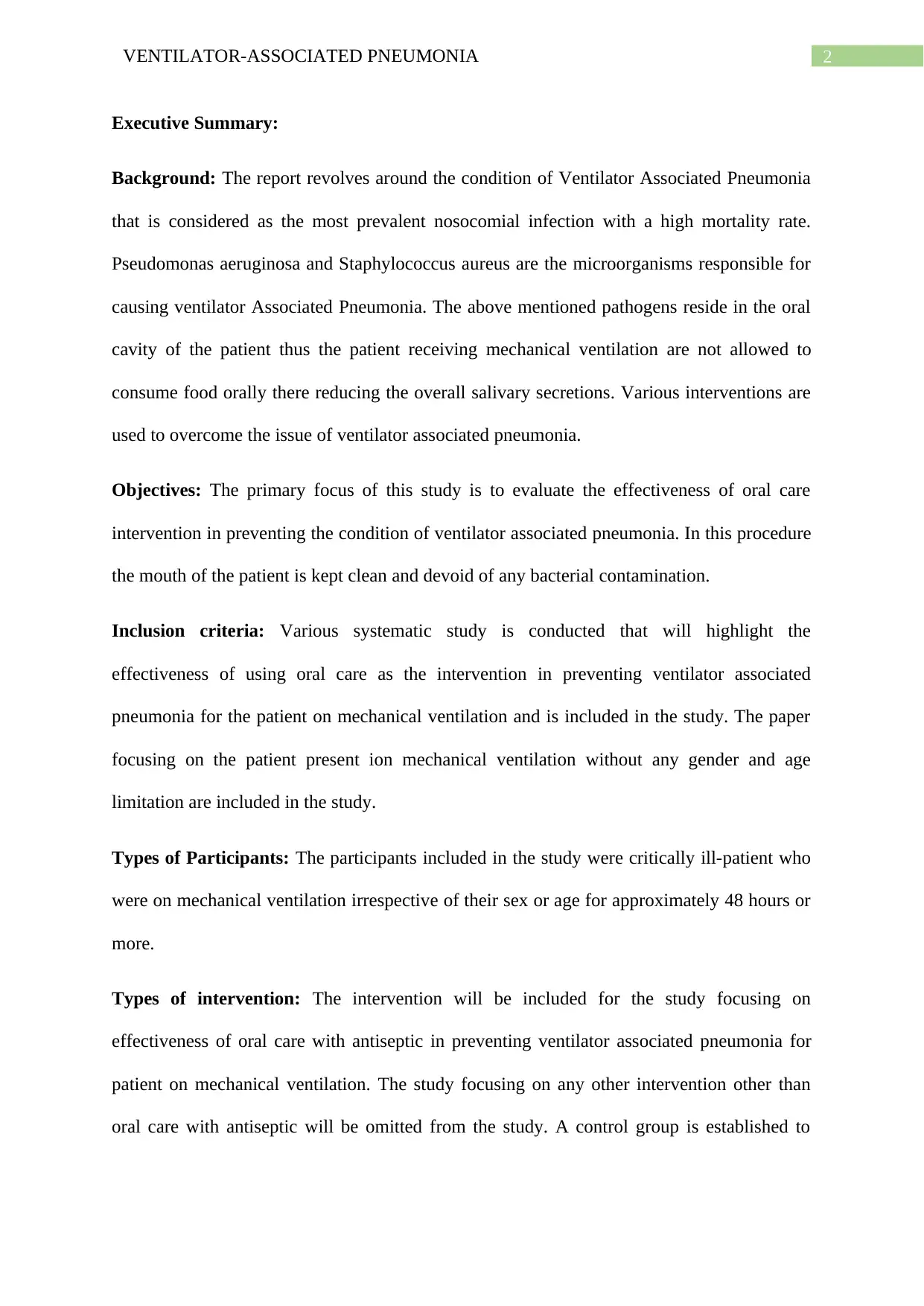
2VENTILATOR-ASSOCIATED PNEUMONIA
Executive Summary:
Background: The report revolves around the condition of Ventilator Associated Pneumonia
that is considered as the most prevalent nosocomial infection with a high mortality rate.
Pseudomonas aeruginosa and Staphylococcus aureus are the microorganisms responsible for
causing ventilator Associated Pneumonia. The above mentioned pathogens reside in the oral
cavity of the patient thus the patient receiving mechanical ventilation are not allowed to
consume food orally there reducing the overall salivary secretions. Various interventions are
used to overcome the issue of ventilator associated pneumonia.
Objectives: The primary focus of this study is to evaluate the effectiveness of oral care
intervention in preventing the condition of ventilator associated pneumonia. In this procedure
the mouth of the patient is kept clean and devoid of any bacterial contamination.
Inclusion criteria: Various systematic study is conducted that will highlight the
effectiveness of using oral care as the intervention in preventing ventilator associated
pneumonia for the patient on mechanical ventilation and is included in the study. The paper
focusing on the patient present ion mechanical ventilation without any gender and age
limitation are included in the study.
Types of Participants: The participants included in the study were critically ill-patient who
were on mechanical ventilation irrespective of their sex or age for approximately 48 hours or
more.
Types of intervention: The intervention will be included for the study focusing on
effectiveness of oral care with antiseptic in preventing ventilator associated pneumonia for
patient on mechanical ventilation. The study focusing on any other intervention other than
oral care with antiseptic will be omitted from the study. A control group is established to
Executive Summary:
Background: The report revolves around the condition of Ventilator Associated Pneumonia
that is considered as the most prevalent nosocomial infection with a high mortality rate.
Pseudomonas aeruginosa and Staphylococcus aureus are the microorganisms responsible for
causing ventilator Associated Pneumonia. The above mentioned pathogens reside in the oral
cavity of the patient thus the patient receiving mechanical ventilation are not allowed to
consume food orally there reducing the overall salivary secretions. Various interventions are
used to overcome the issue of ventilator associated pneumonia.
Objectives: The primary focus of this study is to evaluate the effectiveness of oral care
intervention in preventing the condition of ventilator associated pneumonia. In this procedure
the mouth of the patient is kept clean and devoid of any bacterial contamination.
Inclusion criteria: Various systematic study is conducted that will highlight the
effectiveness of using oral care as the intervention in preventing ventilator associated
pneumonia for the patient on mechanical ventilation and is included in the study. The paper
focusing on the patient present ion mechanical ventilation without any gender and age
limitation are included in the study.
Types of Participants: The participants included in the study were critically ill-patient who
were on mechanical ventilation irrespective of their sex or age for approximately 48 hours or
more.
Types of intervention: The intervention will be included for the study focusing on
effectiveness of oral care with antiseptic in preventing ventilator associated pneumonia for
patient on mechanical ventilation. The study focusing on any other intervention other than
oral care with antiseptic will be omitted from the study. A control group is established to
⊘ This is a preview!⊘
Do you want full access?
Subscribe today to unlock all pages.

Trusted by 1+ million students worldwide
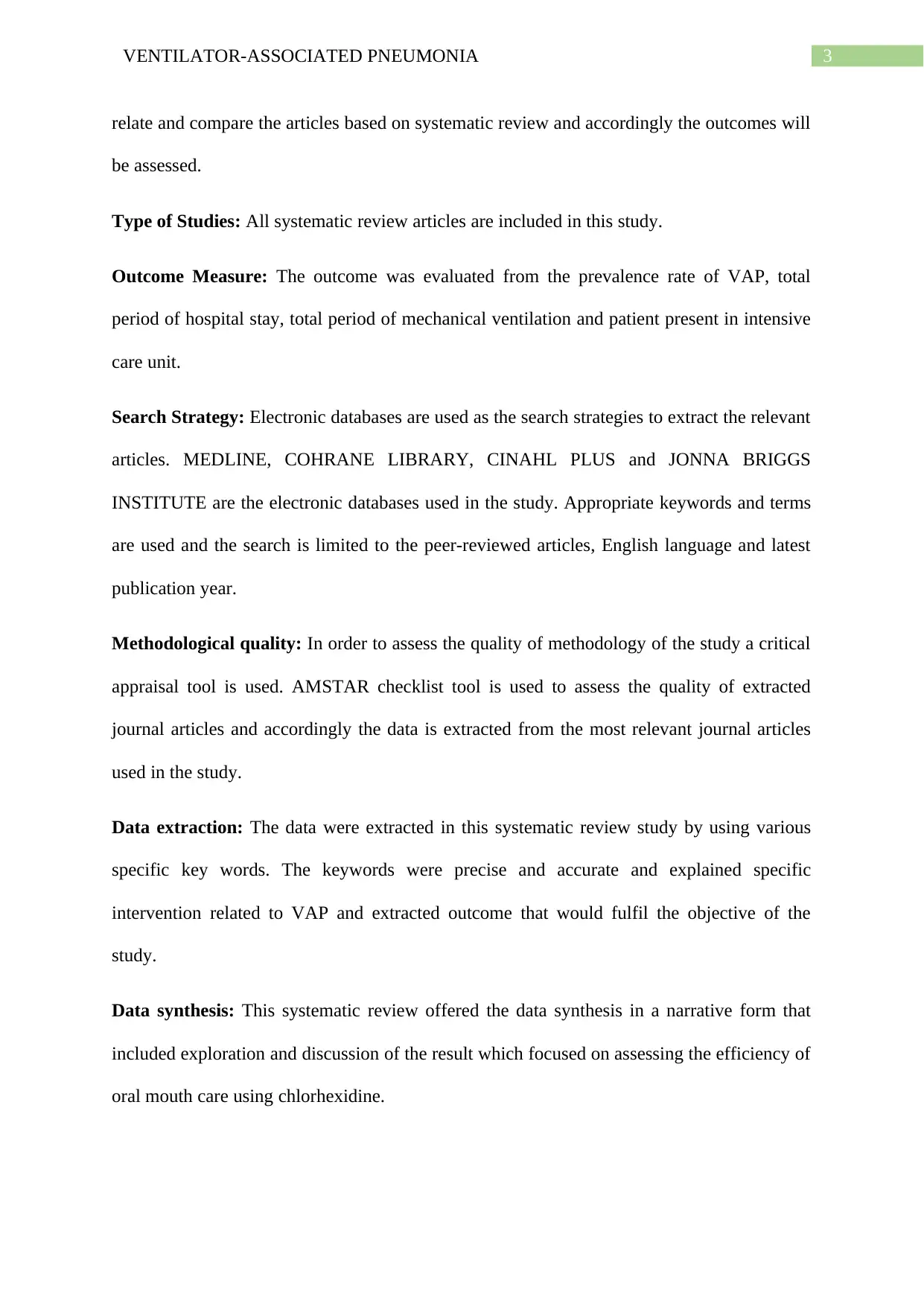
3VENTILATOR-ASSOCIATED PNEUMONIA
relate and compare the articles based on systematic review and accordingly the outcomes will
be assessed.
Type of Studies: All systematic review articles are included in this study.
Outcome Measure: The outcome was evaluated from the prevalence rate of VAP, total
period of hospital stay, total period of mechanical ventilation and patient present in intensive
care unit.
Search Strategy: Electronic databases are used as the search strategies to extract the relevant
articles. MEDLINE, COHRANE LIBRARY, CINAHL PLUS and JONNA BRIGGS
INSTITUTE are the electronic databases used in the study. Appropriate keywords and terms
are used and the search is limited to the peer-reviewed articles, English language and latest
publication year.
Methodological quality: In order to assess the quality of methodology of the study a critical
appraisal tool is used. AMSTAR checklist tool is used to assess the quality of extracted
journal articles and accordingly the data is extracted from the most relevant journal articles
used in the study.
Data extraction: The data were extracted in this systematic review study by using various
specific key words. The keywords were precise and accurate and explained specific
intervention related to VAP and extracted outcome that would fulfil the objective of the
study.
Data synthesis: This systematic review offered the data synthesis in a narrative form that
included exploration and discussion of the result which focused on assessing the efficiency of
oral mouth care using chlorhexidine.
relate and compare the articles based on systematic review and accordingly the outcomes will
be assessed.
Type of Studies: All systematic review articles are included in this study.
Outcome Measure: The outcome was evaluated from the prevalence rate of VAP, total
period of hospital stay, total period of mechanical ventilation and patient present in intensive
care unit.
Search Strategy: Electronic databases are used as the search strategies to extract the relevant
articles. MEDLINE, COHRANE LIBRARY, CINAHL PLUS and JONNA BRIGGS
INSTITUTE are the electronic databases used in the study. Appropriate keywords and terms
are used and the search is limited to the peer-reviewed articles, English language and latest
publication year.
Methodological quality: In order to assess the quality of methodology of the study a critical
appraisal tool is used. AMSTAR checklist tool is used to assess the quality of extracted
journal articles and accordingly the data is extracted from the most relevant journal articles
used in the study.
Data extraction: The data were extracted in this systematic review study by using various
specific key words. The keywords were precise and accurate and explained specific
intervention related to VAP and extracted outcome that would fulfil the objective of the
study.
Data synthesis: This systematic review offered the data synthesis in a narrative form that
included exploration and discussion of the result which focused on assessing the efficiency of
oral mouth care using chlorhexidine.
Paraphrase This Document
Need a fresh take? Get an instant paraphrase of this document with our AI Paraphraser
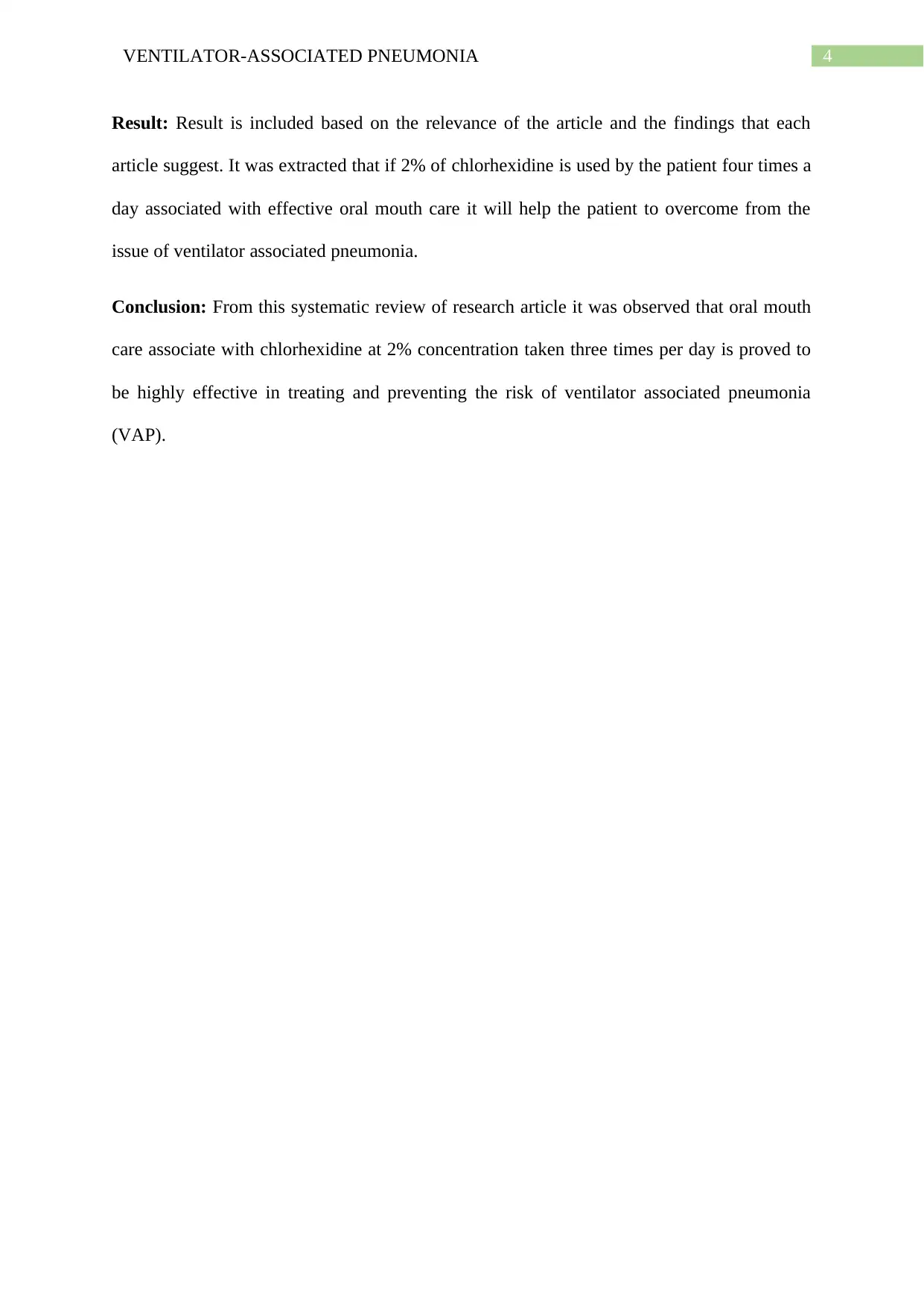
4VENTILATOR-ASSOCIATED PNEUMONIA
Result: Result is included based on the relevance of the article and the findings that each
article suggest. It was extracted that if 2% of chlorhexidine is used by the patient four times a
day associated with effective oral mouth care it will help the patient to overcome from the
issue of ventilator associated pneumonia.
Conclusion: From this systematic review of research article it was observed that oral mouth
care associate with chlorhexidine at 2% concentration taken three times per day is proved to
be highly effective in treating and preventing the risk of ventilator associated pneumonia
(VAP).
Result: Result is included based on the relevance of the article and the findings that each
article suggest. It was extracted that if 2% of chlorhexidine is used by the patient four times a
day associated with effective oral mouth care it will help the patient to overcome from the
issue of ventilator associated pneumonia.
Conclusion: From this systematic review of research article it was observed that oral mouth
care associate with chlorhexidine at 2% concentration taken three times per day is proved to
be highly effective in treating and preventing the risk of ventilator associated pneumonia
(VAP).
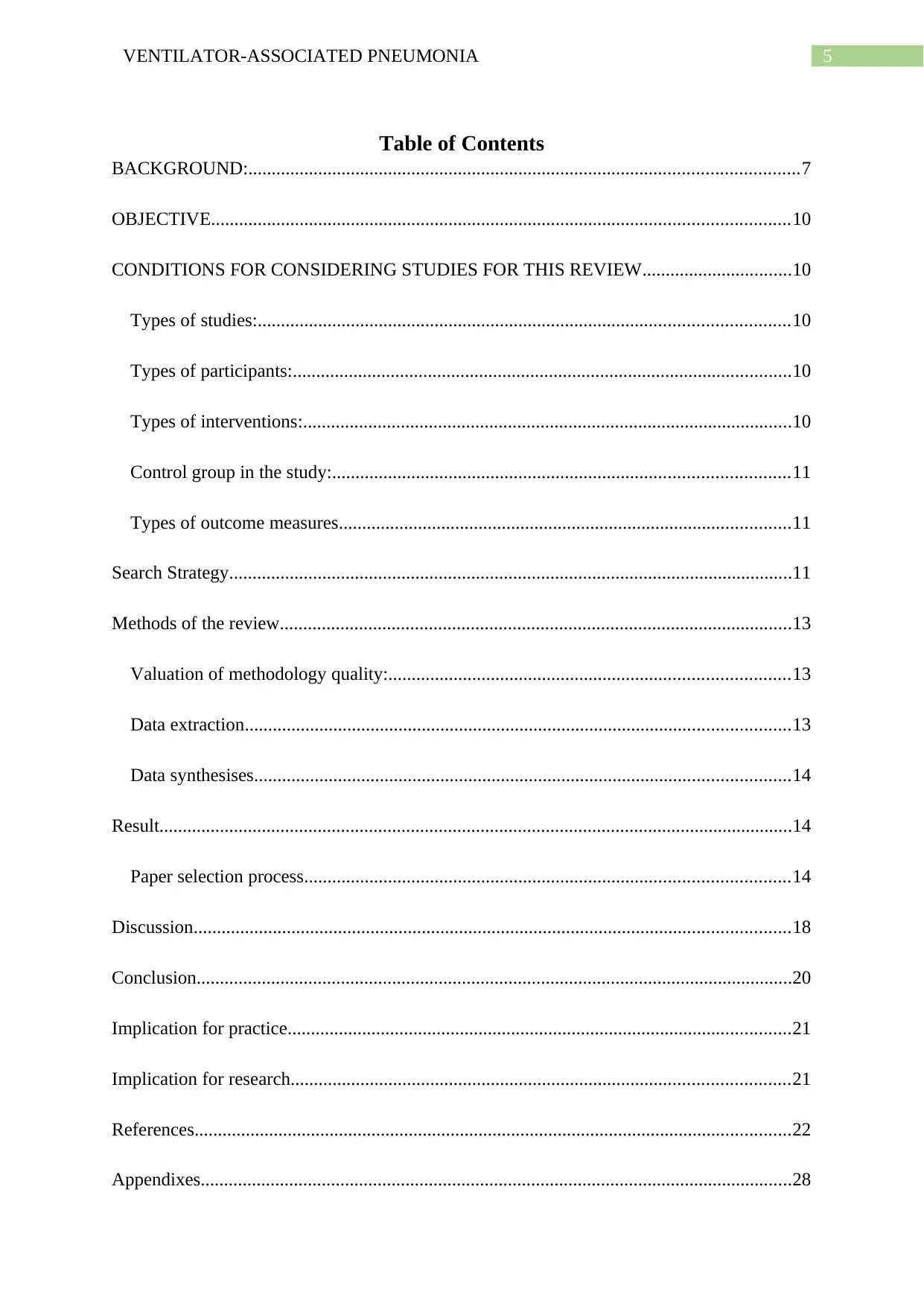
5VENTILATOR-ASSOCIATED PNEUMONIA
Table of Contents
BACKGROUND:......................................................................................................................7
OBJECTIVE............................................................................................................................10
CONDITIONS FOR CONSIDERING STUDIES FOR THIS REVIEW................................10
Types of studies:..................................................................................................................10
Types of participants:...........................................................................................................10
Types of interventions:.........................................................................................................10
Control group in the study:..................................................................................................11
Types of outcome measures.................................................................................................11
Search Strategy.........................................................................................................................11
Methods of the review..............................................................................................................13
Valuation of methodology quality:......................................................................................13
Data extraction.....................................................................................................................13
Data synthesises...................................................................................................................14
Result........................................................................................................................................14
Paper selection process........................................................................................................14
Discussion................................................................................................................................18
Conclusion................................................................................................................................20
Implication for practice............................................................................................................21
Implication for research...........................................................................................................21
References................................................................................................................................22
Appendixes...............................................................................................................................28
Table of Contents
BACKGROUND:......................................................................................................................7
OBJECTIVE............................................................................................................................10
CONDITIONS FOR CONSIDERING STUDIES FOR THIS REVIEW................................10
Types of studies:..................................................................................................................10
Types of participants:...........................................................................................................10
Types of interventions:.........................................................................................................10
Control group in the study:..................................................................................................11
Types of outcome measures.................................................................................................11
Search Strategy.........................................................................................................................11
Methods of the review..............................................................................................................13
Valuation of methodology quality:......................................................................................13
Data extraction.....................................................................................................................13
Data synthesises...................................................................................................................14
Result........................................................................................................................................14
Paper selection process........................................................................................................14
Discussion................................................................................................................................18
Conclusion................................................................................................................................20
Implication for practice............................................................................................................21
Implication for research...........................................................................................................21
References................................................................................................................................22
Appendixes...............................................................................................................................28
⊘ This is a preview!⊘
Do you want full access?
Subscribe today to unlock all pages.

Trusted by 1+ million students worldwide
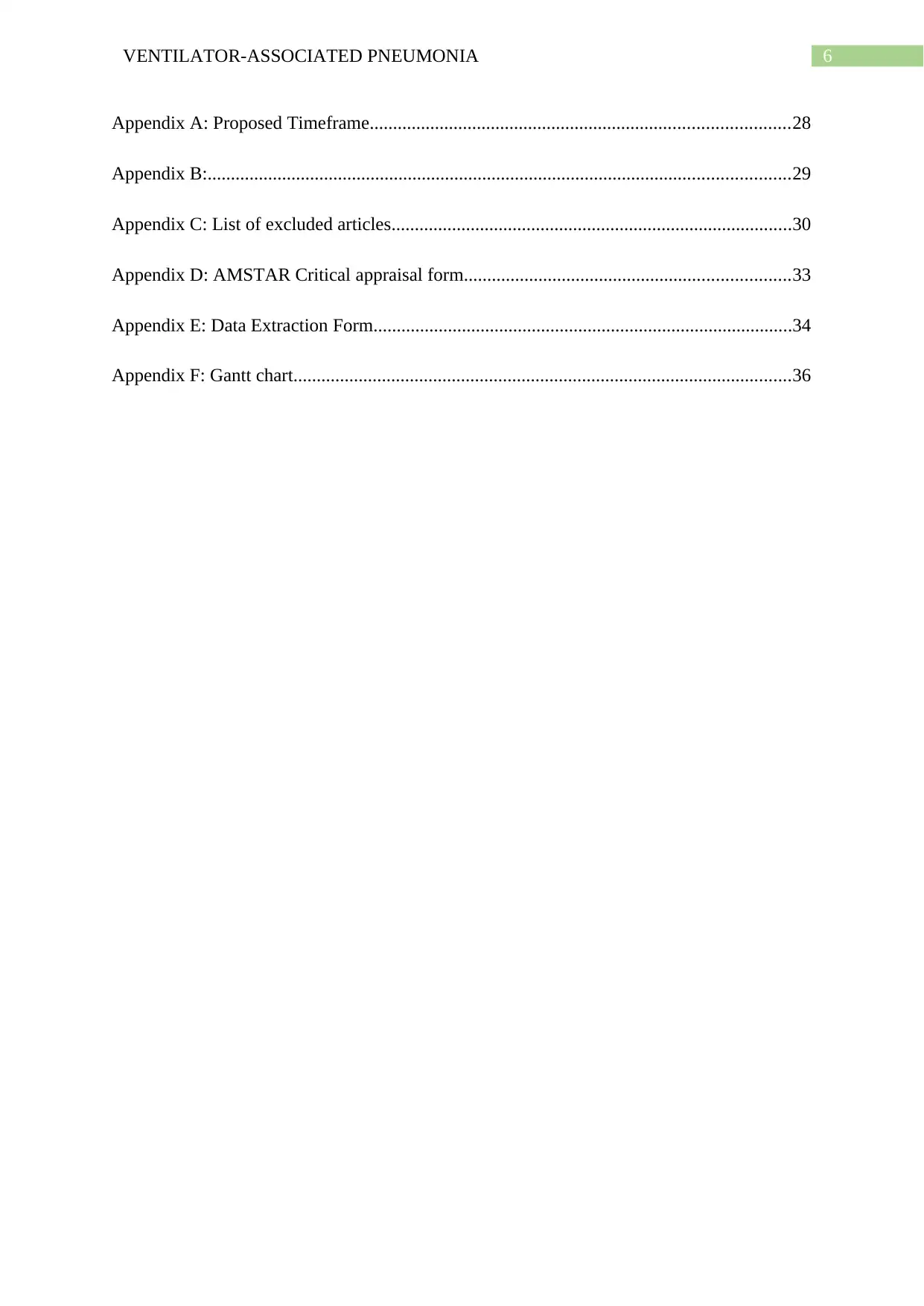
6VENTILATOR-ASSOCIATED PNEUMONIA
Appendix A: Proposed Timeframe..........................................................................................28
Appendix B:.............................................................................................................................29
Appendix C: List of excluded articles......................................................................................30
Appendix D: AMSTAR Critical appraisal form......................................................................33
Appendix E: Data Extraction Form..........................................................................................34
Appendix F: Gantt chart...........................................................................................................36
Appendix A: Proposed Timeframe..........................................................................................28
Appendix B:.............................................................................................................................29
Appendix C: List of excluded articles......................................................................................30
Appendix D: AMSTAR Critical appraisal form......................................................................33
Appendix E: Data Extraction Form..........................................................................................34
Appendix F: Gantt chart...........................................................................................................36
Paraphrase This Document
Need a fresh take? Get an instant paraphrase of this document with our AI Paraphraser
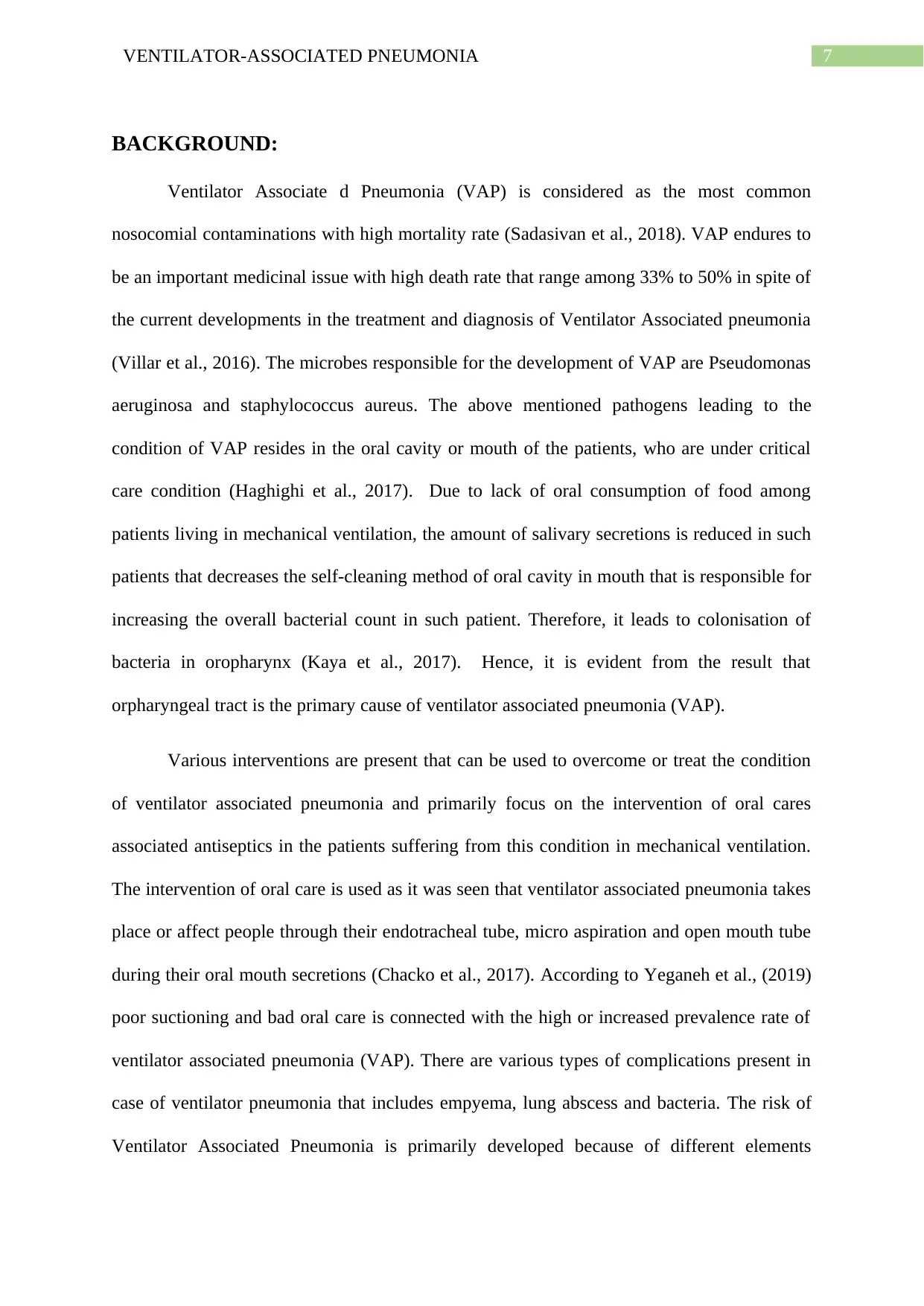
7VENTILATOR-ASSOCIATED PNEUMONIA
BACKGROUND:
Ventilator Associate d Pneumonia (VAP) is considered as the most common
nosocomial contaminations with high mortality rate (Sadasivan et al., 2018). VAP endures to
be an important medicinal issue with high death rate that range among 33% to 50% in spite of
the current developments in the treatment and diagnosis of Ventilator Associated pneumonia
(Villar et al., 2016). The microbes responsible for the development of VAP are Pseudomonas
aeruginosa and staphylococcus aureus. The above mentioned pathogens leading to the
condition of VAP resides in the oral cavity or mouth of the patients, who are under critical
care condition (Haghighi et al., 2017). Due to lack of oral consumption of food among
patients living in mechanical ventilation, the amount of salivary secretions is reduced in such
patients that decreases the self-cleaning method of oral cavity in mouth that is responsible for
increasing the overall bacterial count in such patient. Therefore, it leads to colonisation of
bacteria in oropharynx (Kaya et al., 2017). Hence, it is evident from the result that
orpharyngeal tract is the primary cause of ventilator associated pneumonia (VAP).
Various interventions are present that can be used to overcome or treat the condition
of ventilator associated pneumonia and primarily focus on the intervention of oral cares
associated antiseptics in the patients suffering from this condition in mechanical ventilation.
The intervention of oral care is used as it was seen that ventilator associated pneumonia takes
place or affect people through their endotracheal tube, micro aspiration and open mouth tube
during their oral mouth secretions (Chacko et al., 2017). According to Yeganeh et al., (2019)
poor suctioning and bad oral care is connected with the high or increased prevalence rate of
ventilator associated pneumonia (VAP). There are various types of complications present in
case of ventilator pneumonia that includes empyema, lung abscess and bacteria. The risk of
Ventilator Associated Pneumonia is primarily developed because of different elements
BACKGROUND:
Ventilator Associate d Pneumonia (VAP) is considered as the most common
nosocomial contaminations with high mortality rate (Sadasivan et al., 2018). VAP endures to
be an important medicinal issue with high death rate that range among 33% to 50% in spite of
the current developments in the treatment and diagnosis of Ventilator Associated pneumonia
(Villar et al., 2016). The microbes responsible for the development of VAP are Pseudomonas
aeruginosa and staphylococcus aureus. The above mentioned pathogens leading to the
condition of VAP resides in the oral cavity or mouth of the patients, who are under critical
care condition (Haghighi et al., 2017). Due to lack of oral consumption of food among
patients living in mechanical ventilation, the amount of salivary secretions is reduced in such
patients that decreases the self-cleaning method of oral cavity in mouth that is responsible for
increasing the overall bacterial count in such patient. Therefore, it leads to colonisation of
bacteria in oropharynx (Kaya et al., 2017). Hence, it is evident from the result that
orpharyngeal tract is the primary cause of ventilator associated pneumonia (VAP).
Various interventions are present that can be used to overcome or treat the condition
of ventilator associated pneumonia and primarily focus on the intervention of oral cares
associated antiseptics in the patients suffering from this condition in mechanical ventilation.
The intervention of oral care is used as it was seen that ventilator associated pneumonia takes
place or affect people through their endotracheal tube, micro aspiration and open mouth tube
during their oral mouth secretions (Chacko et al., 2017). According to Yeganeh et al., (2019)
poor suctioning and bad oral care is connected with the high or increased prevalence rate of
ventilator associated pneumonia (VAP). There are various types of complications present in
case of ventilator pneumonia that includes empyema, lung abscess and bacteria. The risk of
Ventilator Associated Pneumonia is primarily developed because of different elements
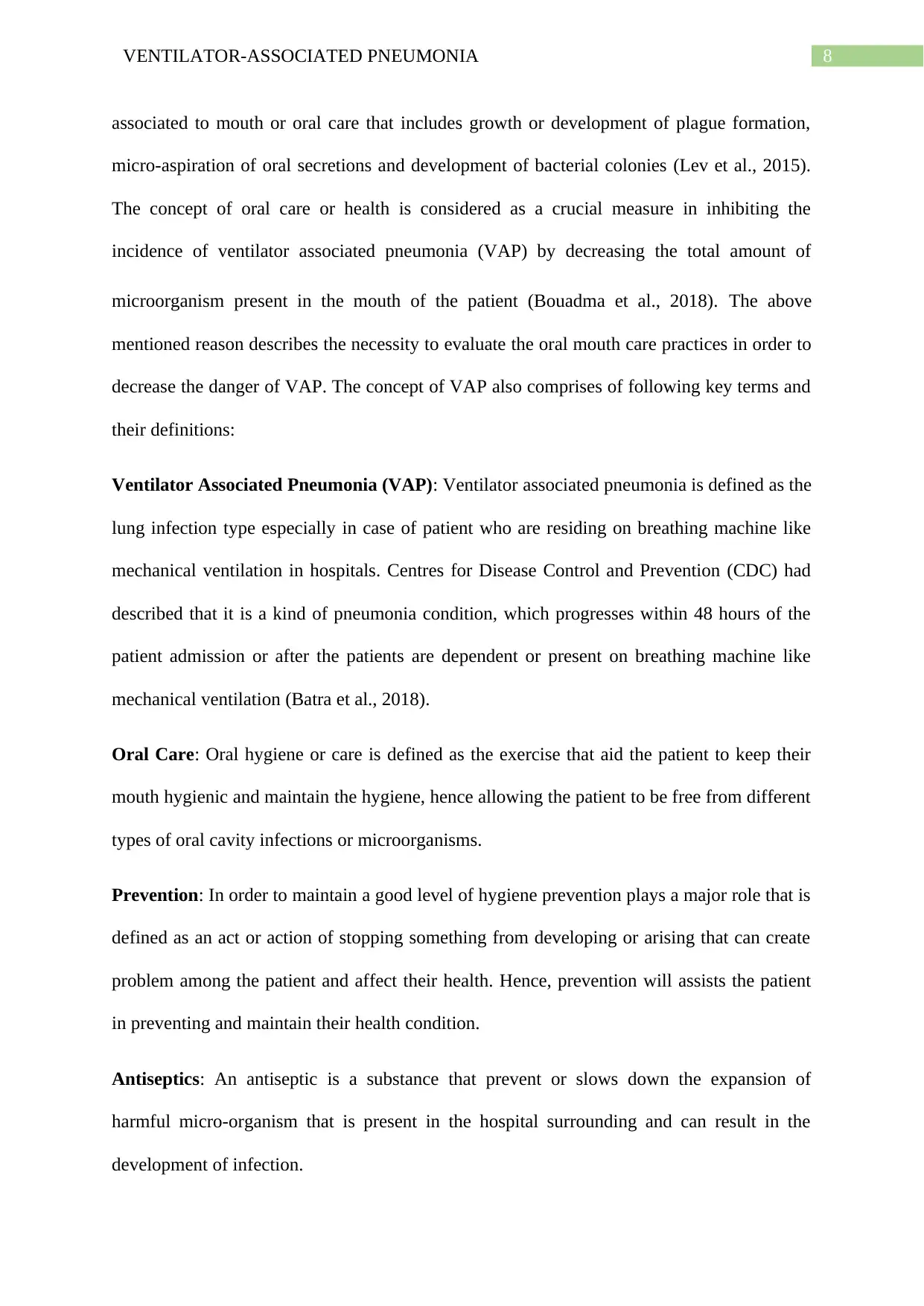
8VENTILATOR-ASSOCIATED PNEUMONIA
associated to mouth or oral care that includes growth or development of plague formation,
micro-aspiration of oral secretions and development of bacterial colonies (Lev et al., 2015).
The concept of oral care or health is considered as a crucial measure in inhibiting the
incidence of ventilator associated pneumonia (VAP) by decreasing the total amount of
microorganism present in the mouth of the patient (Bouadma et al., 2018). The above
mentioned reason describes the necessity to evaluate the oral mouth care practices in order to
decrease the danger of VAP. The concept of VAP also comprises of following key terms and
their definitions:
Ventilator Associated Pneumonia (VAP): Ventilator associated pneumonia is defined as the
lung infection type especially in case of patient who are residing on breathing machine like
mechanical ventilation in hospitals. Centres for Disease Control and Prevention (CDC) had
described that it is a kind of pneumonia condition, which progresses within 48 hours of the
patient admission or after the patients are dependent or present on breathing machine like
mechanical ventilation (Batra et al., 2018).
Oral Care: Oral hygiene or care is defined as the exercise that aid the patient to keep their
mouth hygienic and maintain the hygiene, hence allowing the patient to be free from different
types of oral cavity infections or microorganisms.
Prevention: In order to maintain a good level of hygiene prevention plays a major role that is
defined as an act or action of stopping something from developing or arising that can create
problem among the patient and affect their health. Hence, prevention will assists the patient
in preventing and maintain their health condition.
Antiseptics: An antiseptic is a substance that prevent or slows down the expansion of
harmful micro-organism that is present in the hospital surrounding and can result in the
development of infection.
associated to mouth or oral care that includes growth or development of plague formation,
micro-aspiration of oral secretions and development of bacterial colonies (Lev et al., 2015).
The concept of oral care or health is considered as a crucial measure in inhibiting the
incidence of ventilator associated pneumonia (VAP) by decreasing the total amount of
microorganism present in the mouth of the patient (Bouadma et al., 2018). The above
mentioned reason describes the necessity to evaluate the oral mouth care practices in order to
decrease the danger of VAP. The concept of VAP also comprises of following key terms and
their definitions:
Ventilator Associated Pneumonia (VAP): Ventilator associated pneumonia is defined as the
lung infection type especially in case of patient who are residing on breathing machine like
mechanical ventilation in hospitals. Centres for Disease Control and Prevention (CDC) had
described that it is a kind of pneumonia condition, which progresses within 48 hours of the
patient admission or after the patients are dependent or present on breathing machine like
mechanical ventilation (Batra et al., 2018).
Oral Care: Oral hygiene or care is defined as the exercise that aid the patient to keep their
mouth hygienic and maintain the hygiene, hence allowing the patient to be free from different
types of oral cavity infections or microorganisms.
Prevention: In order to maintain a good level of hygiene prevention plays a major role that is
defined as an act or action of stopping something from developing or arising that can create
problem among the patient and affect their health. Hence, prevention will assists the patient
in preventing and maintain their health condition.
Antiseptics: An antiseptic is a substance that prevent or slows down the expansion of
harmful micro-organism that is present in the hospital surrounding and can result in the
development of infection.
⊘ This is a preview!⊘
Do you want full access?
Subscribe today to unlock all pages.

Trusted by 1+ million students worldwide
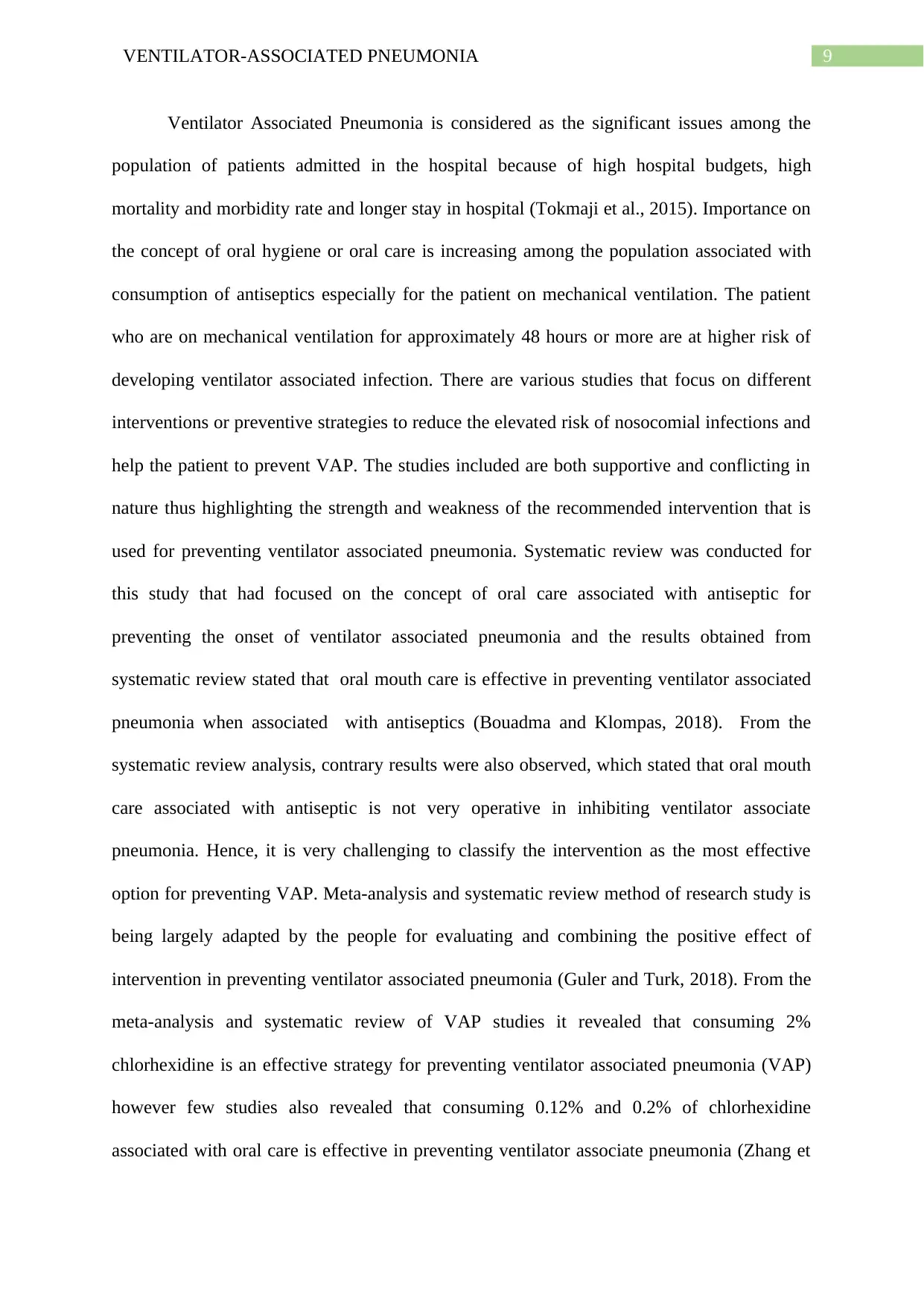
9VENTILATOR-ASSOCIATED PNEUMONIA
Ventilator Associated Pneumonia is considered as the significant issues among the
population of patients admitted in the hospital because of high hospital budgets, high
mortality and morbidity rate and longer stay in hospital (Tokmaji et al., 2015). Importance on
the concept of oral hygiene or oral care is increasing among the population associated with
consumption of antiseptics especially for the patient on mechanical ventilation. The patient
who are on mechanical ventilation for approximately 48 hours or more are at higher risk of
developing ventilator associated infection. There are various studies that focus on different
interventions or preventive strategies to reduce the elevated risk of nosocomial infections and
help the patient to prevent VAP. The studies included are both supportive and conflicting in
nature thus highlighting the strength and weakness of the recommended intervention that is
used for preventing ventilator associated pneumonia. Systematic review was conducted for
this study that had focused on the concept of oral care associated with antiseptic for
preventing the onset of ventilator associated pneumonia and the results obtained from
systematic review stated that oral mouth care is effective in preventing ventilator associated
pneumonia when associated with antiseptics (Bouadma and Klompas, 2018). From the
systematic review analysis, contrary results were also observed, which stated that oral mouth
care associated with antiseptic is not very operative in inhibiting ventilator associate
pneumonia. Hence, it is very challenging to classify the intervention as the most effective
option for preventing VAP. Meta-analysis and systematic review method of research study is
being largely adapted by the people for evaluating and combining the positive effect of
intervention in preventing ventilator associated pneumonia (Guler and Turk, 2018). From the
meta-analysis and systematic review of VAP studies it revealed that consuming 2%
chlorhexidine is an effective strategy for preventing ventilator associated pneumonia (VAP)
however few studies also revealed that consuming 0.12% and 0.2% of chlorhexidine
associated with oral care is effective in preventing ventilator associate pneumonia (Zhang et
Ventilator Associated Pneumonia is considered as the significant issues among the
population of patients admitted in the hospital because of high hospital budgets, high
mortality and morbidity rate and longer stay in hospital (Tokmaji et al., 2015). Importance on
the concept of oral hygiene or oral care is increasing among the population associated with
consumption of antiseptics especially for the patient on mechanical ventilation. The patient
who are on mechanical ventilation for approximately 48 hours or more are at higher risk of
developing ventilator associated infection. There are various studies that focus on different
interventions or preventive strategies to reduce the elevated risk of nosocomial infections and
help the patient to prevent VAP. The studies included are both supportive and conflicting in
nature thus highlighting the strength and weakness of the recommended intervention that is
used for preventing ventilator associated pneumonia. Systematic review was conducted for
this study that had focused on the concept of oral care associated with antiseptic for
preventing the onset of ventilator associated pneumonia and the results obtained from
systematic review stated that oral mouth care is effective in preventing ventilator associated
pneumonia when associated with antiseptics (Bouadma and Klompas, 2018). From the
systematic review analysis, contrary results were also observed, which stated that oral mouth
care associated with antiseptic is not very operative in inhibiting ventilator associate
pneumonia. Hence, it is very challenging to classify the intervention as the most effective
option for preventing VAP. Meta-analysis and systematic review method of research study is
being largely adapted by the people for evaluating and combining the positive effect of
intervention in preventing ventilator associated pneumonia (Guler and Turk, 2018). From the
meta-analysis and systematic review of VAP studies it revealed that consuming 2%
chlorhexidine is an effective strategy for preventing ventilator associated pneumonia (VAP)
however few studies also revealed that consuming 0.12% and 0.2% of chlorhexidine
associated with oral care is effective in preventing ventilator associate pneumonia (Zhang et
Paraphrase This Document
Need a fresh take? Get an instant paraphrase of this document with our AI Paraphraser
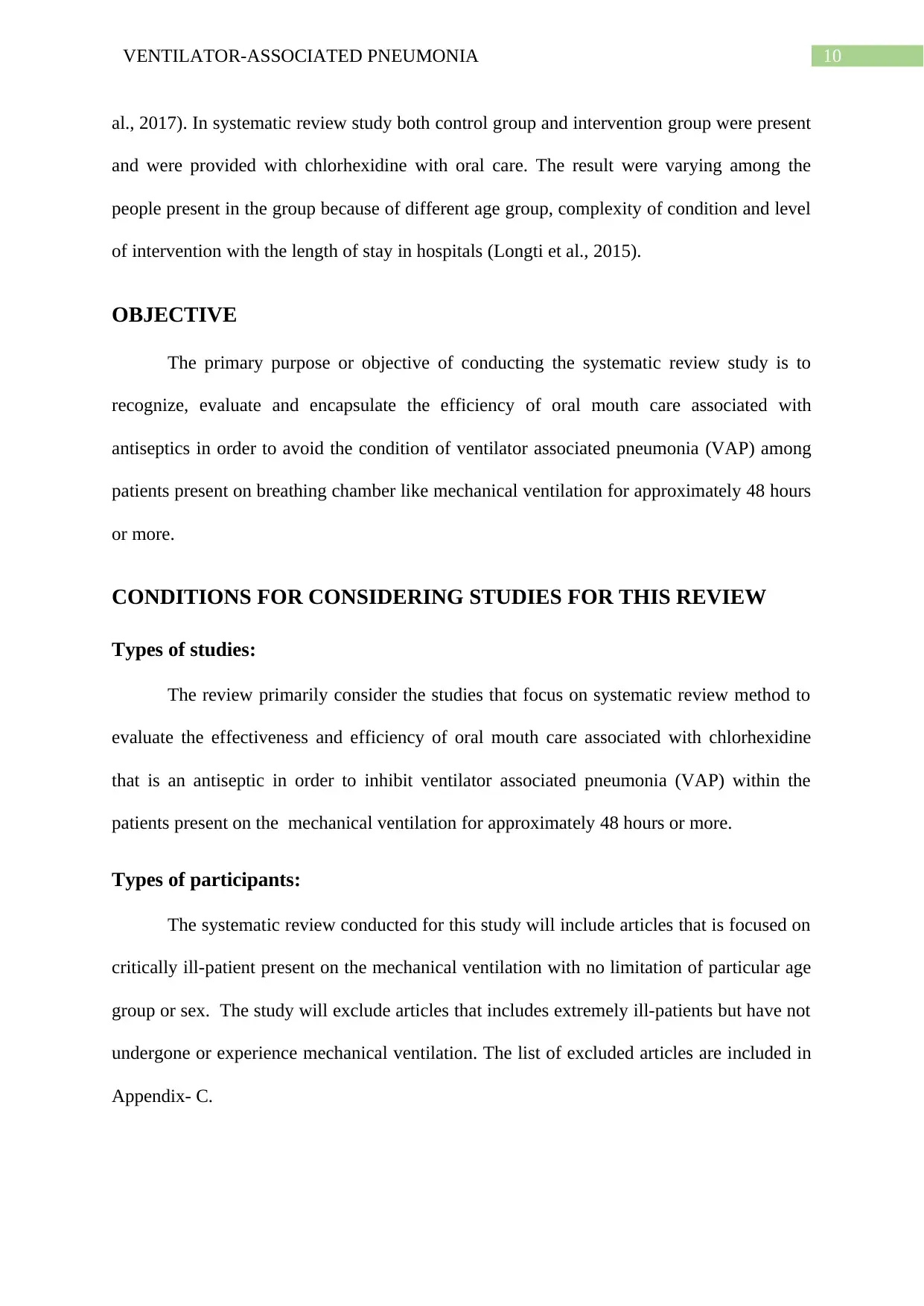
10VENTILATOR-ASSOCIATED PNEUMONIA
al., 2017). In systematic review study both control group and intervention group were present
and were provided with chlorhexidine with oral care. The result were varying among the
people present in the group because of different age group, complexity of condition and level
of intervention with the length of stay in hospitals (Longti et al., 2015).
OBJECTIVE
The primary purpose or objective of conducting the systematic review study is to
recognize, evaluate and encapsulate the efficiency of oral mouth care associated with
antiseptics in order to avoid the condition of ventilator associated pneumonia (VAP) among
patients present on breathing chamber like mechanical ventilation for approximately 48 hours
or more.
CONDITIONS FOR CONSIDERING STUDIES FOR THIS REVIEW
Types of studies:
The review primarily consider the studies that focus on systematic review method to
evaluate the effectiveness and efficiency of oral mouth care associated with chlorhexidine
that is an antiseptic in order to inhibit ventilator associated pneumonia (VAP) within the
patients present on the mechanical ventilation for approximately 48 hours or more.
Types of participants:
The systematic review conducted for this study will include articles that is focused on
critically ill-patient present on the mechanical ventilation with no limitation of particular age
group or sex. The study will exclude articles that includes extremely ill-patients but have not
undergone or experience mechanical ventilation. The list of excluded articles are included in
Appendix- C.
al., 2017). In systematic review study both control group and intervention group were present
and were provided with chlorhexidine with oral care. The result were varying among the
people present in the group because of different age group, complexity of condition and level
of intervention with the length of stay in hospitals (Longti et al., 2015).
OBJECTIVE
The primary purpose or objective of conducting the systematic review study is to
recognize, evaluate and encapsulate the efficiency of oral mouth care associated with
antiseptics in order to avoid the condition of ventilator associated pneumonia (VAP) among
patients present on breathing chamber like mechanical ventilation for approximately 48 hours
or more.
CONDITIONS FOR CONSIDERING STUDIES FOR THIS REVIEW
Types of studies:
The review primarily consider the studies that focus on systematic review method to
evaluate the effectiveness and efficiency of oral mouth care associated with chlorhexidine
that is an antiseptic in order to inhibit ventilator associated pneumonia (VAP) within the
patients present on the mechanical ventilation for approximately 48 hours or more.
Types of participants:
The systematic review conducted for this study will include articles that is focused on
critically ill-patient present on the mechanical ventilation with no limitation of particular age
group or sex. The study will exclude articles that includes extremely ill-patients but have not
undergone or experience mechanical ventilation. The list of excluded articles are included in
Appendix- C.
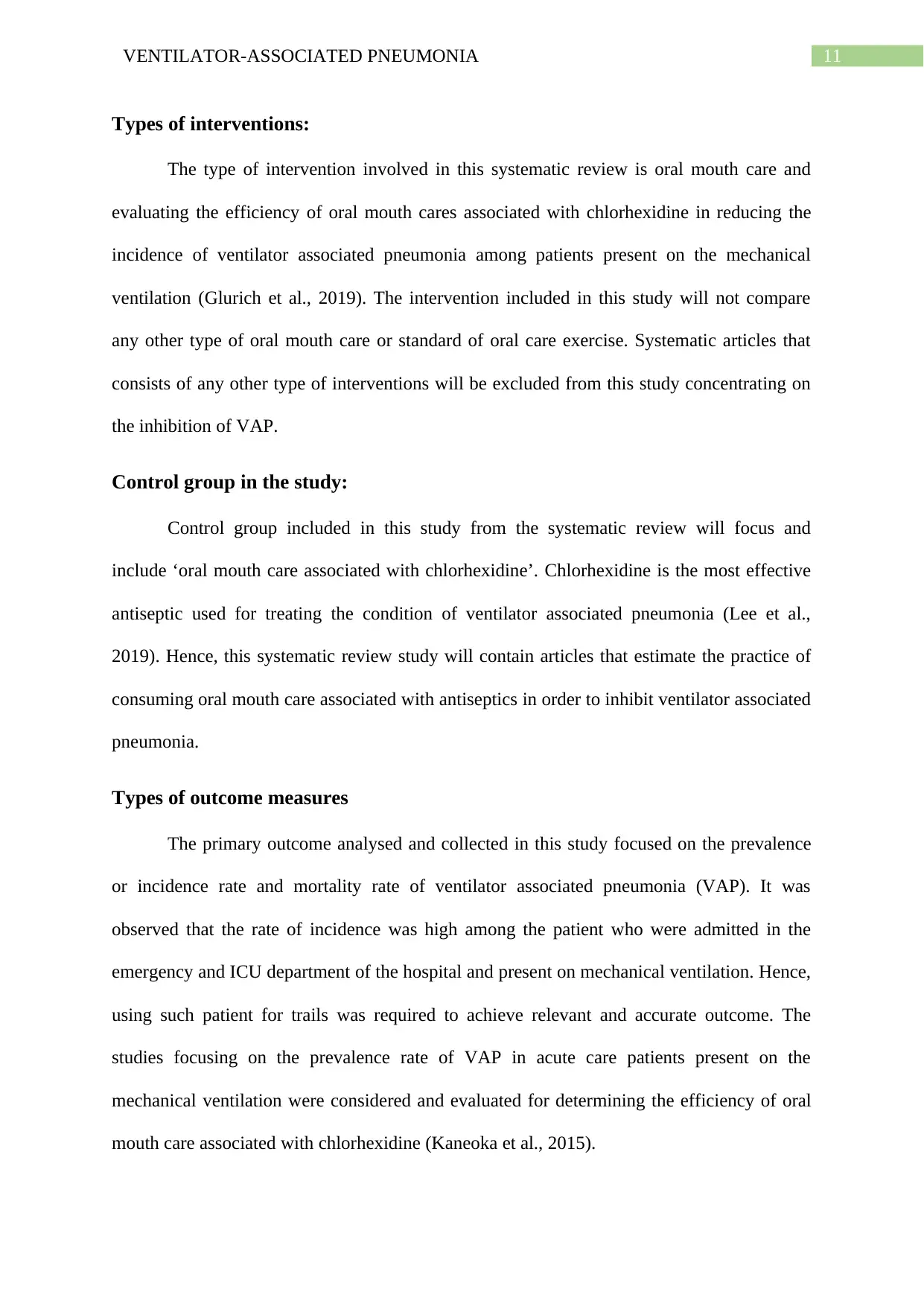
11VENTILATOR-ASSOCIATED PNEUMONIA
Types of interventions:
The type of intervention involved in this systematic review is oral mouth care and
evaluating the efficiency of oral mouth cares associated with chlorhexidine in reducing the
incidence of ventilator associated pneumonia among patients present on the mechanical
ventilation (Glurich et al., 2019). The intervention included in this study will not compare
any other type of oral mouth care or standard of oral care exercise. Systematic articles that
consists of any other type of interventions will be excluded from this study concentrating on
the inhibition of VAP.
Control group in the study:
Control group included in this study from the systematic review will focus and
include ‘oral mouth care associated with chlorhexidine’. Chlorhexidine is the most effective
antiseptic used for treating the condition of ventilator associated pneumonia (Lee et al.,
2019). Hence, this systematic review study will contain articles that estimate the practice of
consuming oral mouth care associated with antiseptics in order to inhibit ventilator associated
pneumonia.
Types of outcome measures
The primary outcome analysed and collected in this study focused on the prevalence
or incidence rate and mortality rate of ventilator associated pneumonia (VAP). It was
observed that the rate of incidence was high among the patient who were admitted in the
emergency and ICU department of the hospital and present on mechanical ventilation. Hence,
using such patient for trails was required to achieve relevant and accurate outcome. The
studies focusing on the prevalence rate of VAP in acute care patients present on the
mechanical ventilation were considered and evaluated for determining the efficiency of oral
mouth care associated with chlorhexidine (Kaneoka et al., 2015).
Types of interventions:
The type of intervention involved in this systematic review is oral mouth care and
evaluating the efficiency of oral mouth cares associated with chlorhexidine in reducing the
incidence of ventilator associated pneumonia among patients present on the mechanical
ventilation (Glurich et al., 2019). The intervention included in this study will not compare
any other type of oral mouth care or standard of oral care exercise. Systematic articles that
consists of any other type of interventions will be excluded from this study concentrating on
the inhibition of VAP.
Control group in the study:
Control group included in this study from the systematic review will focus and
include ‘oral mouth care associated with chlorhexidine’. Chlorhexidine is the most effective
antiseptic used for treating the condition of ventilator associated pneumonia (Lee et al.,
2019). Hence, this systematic review study will contain articles that estimate the practice of
consuming oral mouth care associated with antiseptics in order to inhibit ventilator associated
pneumonia.
Types of outcome measures
The primary outcome analysed and collected in this study focused on the prevalence
or incidence rate and mortality rate of ventilator associated pneumonia (VAP). It was
observed that the rate of incidence was high among the patient who were admitted in the
emergency and ICU department of the hospital and present on mechanical ventilation. Hence,
using such patient for trails was required to achieve relevant and accurate outcome. The
studies focusing on the prevalence rate of VAP in acute care patients present on the
mechanical ventilation were considered and evaluated for determining the efficiency of oral
mouth care associated with chlorhexidine (Kaneoka et al., 2015).
⊘ This is a preview!⊘
Do you want full access?
Subscribe today to unlock all pages.

Trusted by 1+ million students worldwide
1 out of 39
Related Documents
Your All-in-One AI-Powered Toolkit for Academic Success.
+13062052269
info@desklib.com
Available 24*7 on WhatsApp / Email
![[object Object]](/_next/static/media/star-bottom.7253800d.svg)
Unlock your academic potential
Copyright © 2020–2025 A2Z Services. All Rights Reserved. Developed and managed by ZUCOL.





